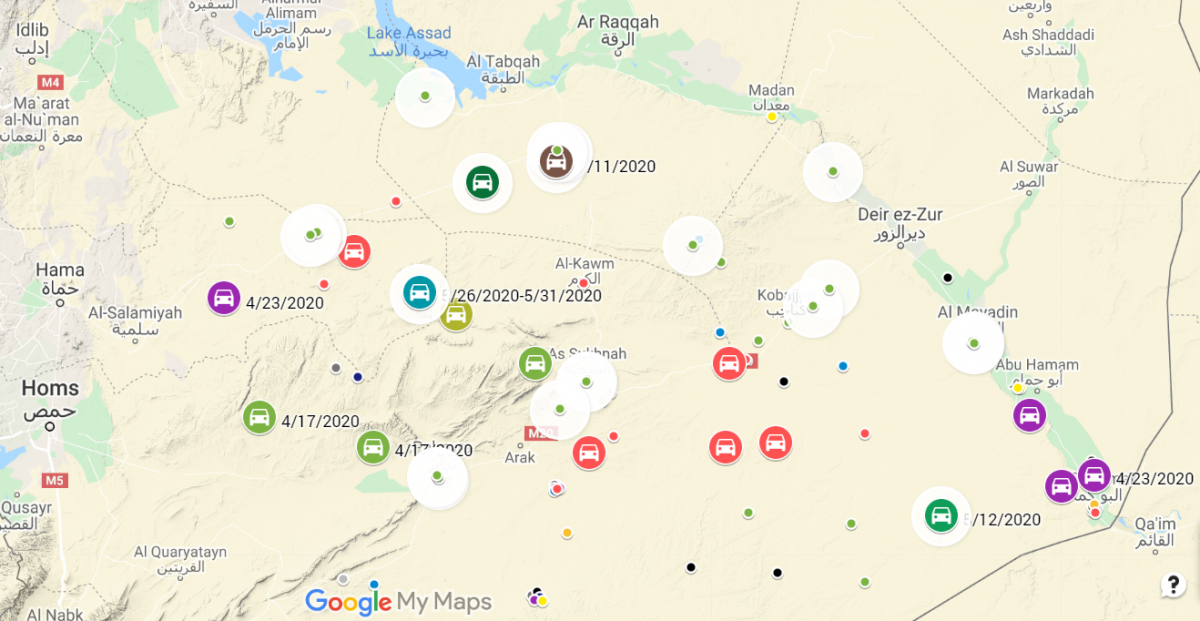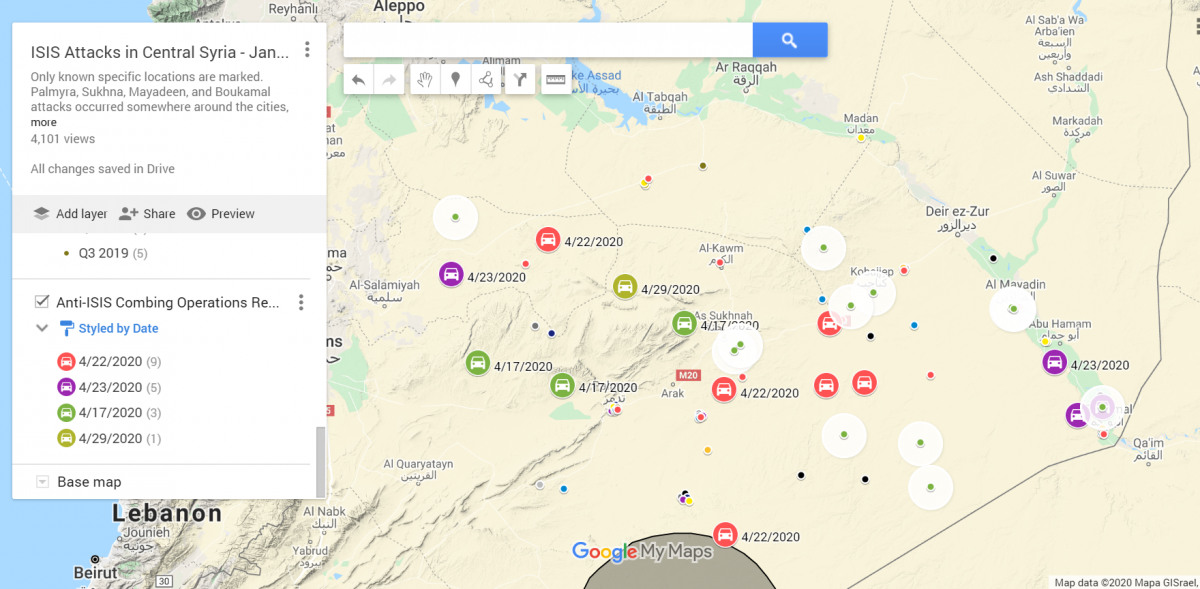CEP Research Analyst Gregory Waters On The ISIS Insurgency In Central Syria
Read ISIS Redux: The Central Syria Insurgency In May 2020 by clicking here.
ISIS Redux: The Central Syria Insurgency In May 2020
By Gregory Waters
Following a lull in the second half of April, ISIS attacks increased in both quantity and geographic diversity during May. This boost in activity coincided with increasingly persistent and widespread anti-ISIS operations conducted by the Syrian regime and its allied militias. Both the ISIS attacks and counter-insurgency operations spread across four governorates: Hama and Raqqa in the north, and Homs and Deir Ez Zor in the south.
ISIS killed at least 27 Syrian regime-affiliated fighters in 18 confirmed attacks occurring on at least 17 days in May. While May had the greatest number of attacks as well as days with reported attacks in 2020, it ranks as only the third deadliest month (behind April and January, respectively). ISIS did not carry out major ambushes or large, complex operations, likely due to the intensity of the Syrian regime’s anti-ISIS operations. Still, the terrorist group effectively used mines and IEDs to regularly harass patrolling security forces. Furthermore, ISIS was able, as it did in April, to successfully create a fake checkpoint on the Palmyra-Deir Ez Zor highway, resulting in the death of at least four soldiers and one civilian. The creation of fake checkpoints—in which ISIS militants use stolen regime uniforms and flags to prey on passing cars—demonstrates a high degree of operational freedom of the groups various cells.
May also marked the first month of sustained ISIS activity in east Hama and Raqqa. ISIS attacks and mines killed more than seven pro-regime fighters in six separate attacks. Among those killed was a commander of Iran’s Islamic Revolutionary Guard Corps (IRGC), whose vehicle was struck by an IED as it drove near Ithriya, Hama. These attacks coincided with two new anti-ISIS operations by pro-regime forces in the governorates.
On May 11, the pro-regime Liwa al-Quds militia launched an operation in Raqqa with the backing of the Syrian Air Force. This is the first known counter-insurgency operation in central Syria to be accompanied by sustained aerial support. This development likely occurred due to the opening of the Tabqa-Raqqa crossing, connecting the Syrian Democratic Forces (SDF)-held and regime-held parts of Raqqa governorate. The crossing opened on the same day the Liwa al-Quds operation began. Liwa al-Quds continues its operation in the Raqqa and east Hama deserts as of the end of May. It recovered some buried mines and IEDs and destroyed several ISIS vehicles. However, it is unclear whether any ISIS fighters were killed.
On May 26, fighters from the National Defense Forces (NDF) in the Christian towns of Suqaylabiyah and Mahardeh began patrolling the east Hama countryside, their second such deployment in as many months. These two towns have a very close relationship with the Russian military, with the militias’ commander having met with the highest-ranking Russian officer in Syria multiple times in April and May. Pictures of NDF fighters during their most recent operations show them using brand new vehicles and outfitted with new Russian equipment. However, this operation, much like the previous one, was mostly carried out for publicity, with the fighters deployed for only five days and engaging no ISIS targets.
In addition to the above-mentioned patrols and others taking place in Homs and Deir Ez Zor, a group of 930 Damascus NDF fighters were deployed to central Syria on May 19. An earlier batch of Damascus NDF fighters were deployed to the same area on February 4.
May appears to have set the stage for an even more violent June. While regime anti-ISIS patrols will likely continue at the same pace or increase in frequency, they have produced little in terms of meaningfully degrading ISIS capabilities. Meanwhile, Syria continues to devote more resources to the ongoing insurgency by ex-rebels in Syria’s southern Dara’a province while its core offensive units remain near Idlib in the northwest, likely awaiting orders to resume the regime’s offensive on the rebel stronghold.

Map of locatable ISIS attacks (highlighted dots) and reported anti-ISIS operations (highlighted cars, color-coded by the date the operation began) in May. To view an interactive version of this map, please click here.
###
Read ISIS Redux: The Central Syria Insurgency In April 2020 by clicking here.
ISIS Redux: The Central Syria Insurgency In April 2020
By Gregory Waters
At the end of 2017, the Syrian regime and Russian President Vladimir Putin proudly proclaimed their militaries’ victory over ISIS. The terrorist group had lost all of the urban centers—and ostensibly the rural areas—it once controlled west of the Euphrates River. Nevertheless, ISIS has been able to effectively wage a sophisticated and deadly insurgency throughout regime-held central Syria for more than two-and-a-half years, as detailed in “‘A Force They Haven’t Seen Before’: Insurgent ISIS in Central Syria” by this author.
ISIS has deployed IEDs and mines, small arms, anti-tank guided missiles and RPGs, car bombs, and fake checkpoints to repeatedly ambush Syrian regime and Russian forces in the Deir Ez Zor, Homs, Raqqa, and Hama governorates. ISIS attacks have spanned more than 15,000 square miles—striking as far west as Khunayfis (just 40 miles from Damascus governorate) and as far north as Rahjan, Hama (just 15 miles from Idlib governorate), and along the length of the Euphrates from Boukamal in the south to Ruseifa in the north.
ISIS has proven to operate a robust intelligence gathering system in central Syria. The group is reportedly responsible for killing high-value targets such as Syrian and Iranian commanders using mines and IEDs and has successfully avoided regime strongpoints during its deep pushes “behind enemy lines,” finding roads through undefended parts of the countryside. In doing so, ISIS has managed to effectively control territory at various times, most recently controlling the crucial Bishri Mountains bordering the Raqqa, Homs, and Deir Ez Zor governorates from April 2019 through February 2020.
For its part, the Syrian regime and its Hezbollah and Iranian allies have been unable to make any serious advances against ISIS’s insurgent cells. Regime anti-ISIS operations appear to consist of military convoys driving from point A to point B and occasionally combing largely empty hamlets throughout the Syrian desert (known as the Badia). Russian assistance has almost exclusively come in the form of air support during the few prolonged ISIS engagements, such as during the two-day battle that took place between Sukhnah and Humaymah beginning on April 9, 2020.
Based on martyrdom reports published by pro-regime Facebook pages, ISIS attacks have killed at least 887 pro-regime fighters, with actual figures likely being twice that. In April 2020, ISIS killed at least 27 Syrian loyalists in Homs, Deir Ez Zor, Raqqa, and Hama. On April 9, ISIS launched two simultaneous attacks in Homs—the first just north of Humaymah and the second south of Sukhna—followed by a third attack deep in north Hama the next day. Clashes in Homs continued for two days and reportedly involved Russian airstrikes. ISIS continued carrying out smaller scale attacks over the next 10 days, ending in an ambush in the Bishri Mountains that left five local loyalist fighters dead. On April 22, the Syrian regime launched a two-day anti-ISIS operation that claimed to target ISIS cells across the entirety of central Syria. However, the regime has not produced evidence of captured or killed ISIS fighters from these operations, and on April 25, ISIS again renewed its attacks near the city of Mayadeen, Deir Ez Zor. Furthermore, on April 30, ISIS successfully ambushed a bus carrying Syrian Arab Army soldiers from southern Deir Ez Zor to Palmyra, killing at least six of them.
ISIS continues to benefit from a high degree of local support and a porous border with Iraq. Unless Damascus can impact these conditions, their hopes of effectively defeating ISIS, even with Russian assistance, will be minimal.
These April attacks and regime anti-ISIS operations are mapped below. ISIS attacks are coded quarterly since January 2018, while anti-ISIS operations are coded by specific date starting in April 2020.

###
